keri
Key Event Receipt Infrastructure - the spec and implementation of the KERI protocol
Definitions
Abbreviations
In alphabetic order:
ACDC = Authentic Chained Data Container Task Force
AID = Autonomic Identifier
AIS = Autonomic Identity System
AN = Autonomic Namespace
BA = Byzantine Agreement
DEL = Duplicitous Event Log
DID = Decentralized Identity or Digital Identity dependent of the context.
DIF = Decentralized Identity Foundation
DDO = DID Document, look up W3D DID standardization for more info
DHT = Distributed Hash Table
DIF = Decentralized Identity Foundation, https://identity.foundation.
DKMI = Decentralized Key Mangement Infrastructure
HSM = Hardware Security Module
IPv4 = standard Internet Protocol, version 4
KAACE = KERI Agreement Algorithm for Control Establishment
KEL = Key Event Log
KERL = Key Event Receipt Log
KERI = Key Event Receipt Infrastructure
KID = KERI Implementation/Improvement Docs
LOA = Levels Of Assurance
PKI = Public Key Infrastructure
PoA = Proof of Authority
PoW = Proof of Work
PR = Pull Request; github terminology
SAI = Self Addressing Identifier
SASCI = Self Addressing self certifying Identifier
SCI = Self Certifying Identifier
SSI = Self Sovereign Identity
TEL = Transaction Event Log
VC = Verifiable Credential, look up W3D DID standardization for more info
VDS = Verifiable Data Structure
WASM = WebAssembly
Definitions in alphabetic order:
Authentic Chained Data Container Task Force
The purpose of the Authentic Chained Data Container (ACDC) Task Force is to draft a TSS (ToIP Standard Specification) that defines the standard requirements for the semantics of Authentic Provenance Chaining of Authentic Data Containers. See more
Ambient verifiability
Verifiable by anyone, anywhere, at anytime. E.g. Ambient Duplicity Detection describes the possibility of detecting duplicity by anyone, anywhere, anytime.
Agent
A representative for an identity. MAY require the use of a wallet. MAY support transfer
Agency
Agents can be people, edge computers and the functionality within wallets. The service an agent offers is agency.
Autonomic Identifier
An identifier that is self-certifying and self-sovereign
Autonomic Namespace
A namespace that is self-certifying and hence self-administrating. ANs are therefore portable = truly self sovereign.
See basic explanation of Namespace.
Autonomic idenity system
In the design of an identity system you need to answer a few questions.
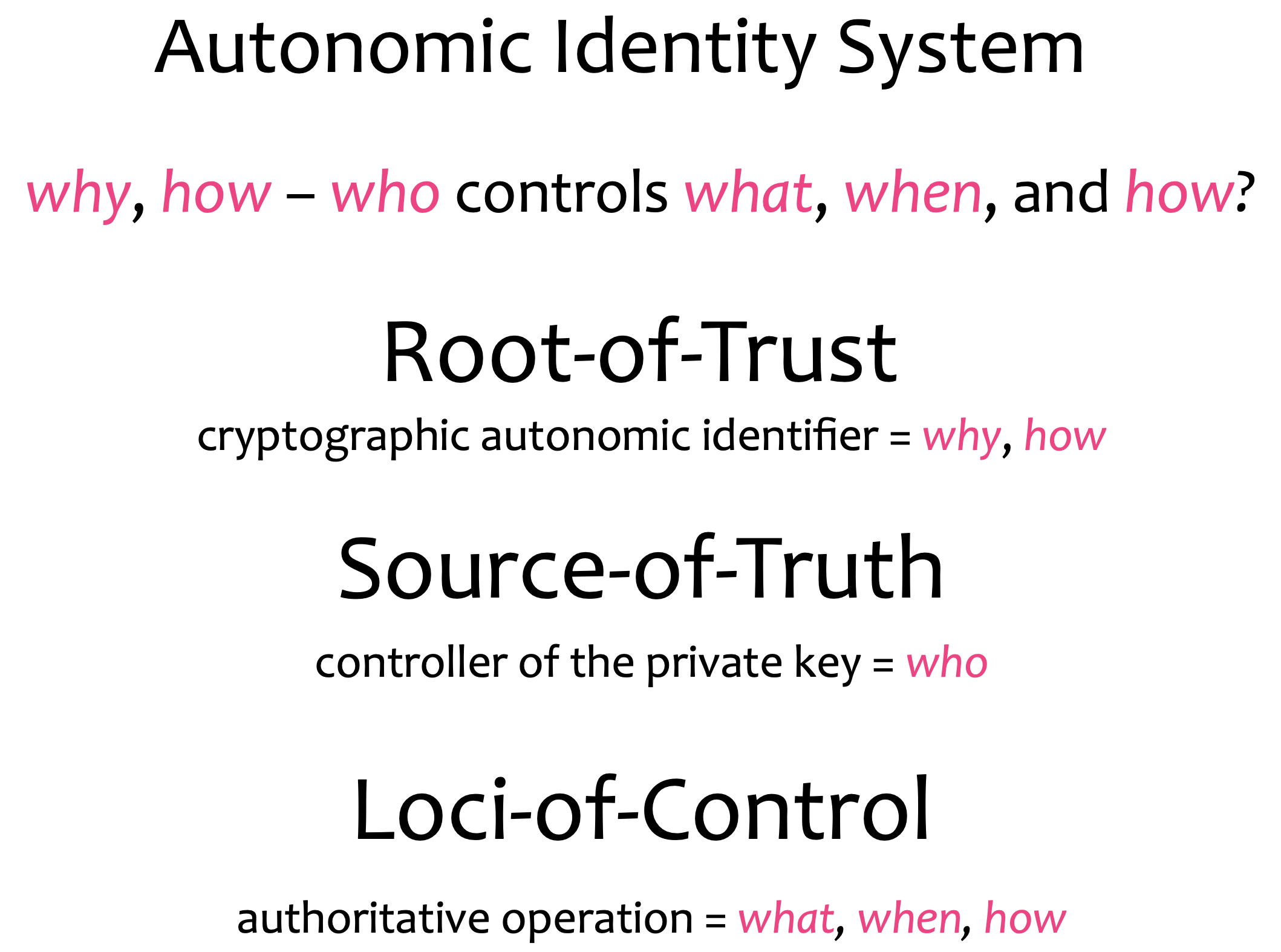
There’s nobody that can intervene with the establishment of the authenticity of a control operation because you can verify all the way back to the root-of-trust.
Byzantine Agreement (non PoW)
Byzantine Agreement is Byzantine fault tolerance of distributed computing systems that enable them to come to consensus despite arbitrary behavior from a fraction of the nodes in the network. BA consensus makes no assumptions about the behavior of nodes in the system. Practical Byzantine Fault Tolerance (pBFT) is the prototypical model for Byzantine agreement, and it can reach consensus fast and efficiently while concurrently decoupling consensus from resources (i.e., financial stake in PoS or electricity in PoW).
More
Claim
An assertion of the truth of something, typically one which is disputed or in doubt. A set of claims might convey personally identifying information: ½name, address, date of birth and citizenship, for example. (Source).
Content-addressable hash
Content addressing is a way to find data in a network using its content rather than its location. The way we do is by taking the content of the content and hashing it. Try uploading an image to IPFS and get the hash using the below button. In the IPFS ecosystem, this hash is called Content Identifier, or CID.
Controller
The entity that has the ability to make changes to an identity, cryptocurrency or verifiable credential.
The controller of an autonomous identifier is the entity (person, organization, or autonomous software) that has the capability, as defined by derivation, to make changes to an Event Log. This capability is typically asserted by the control of a single inception key. In DIDs this is typically asserted by the control of set of cryptographic keys used by software acting on behalf of the controller, though it may also be asserted via other mechanisms. In KERI an AID has one single controller. Note that a DID may have more than one controller, and the DID subject can be the DID controller, or one of them.
Control Authority
In identity systems Control Authority is who controls what and that is the primary factor in determining the basis for trust in them. The entity with control authority takes action through operations that affect the
- creation (inception)
- updating
- rotation
- revocation
- deletion
- and delegation of the authentication factors and their relation to the identifier.
How these events are ordered and their dependence on previous operations is important. The record of these operations is the source of truth for the identity system.
Correlation
An identifier used to indicate that external parties have observed how wallet contents are related. For example, when a public key is reused, it conveys that some common entity is controlling both identifiers. Tracking correlation allows for software to warn when some new information might be about to be exposed, for example: “Looks like you are about to send crypo currency, from an account you frequently use to a new account you just created.”
Cryptocurrency
A digital asset designed to work as a medium of exchange wherein individual coin ownership records are stored in a digital ledger or computerized database using strong cryptography to secure transaction record entries, to control the creation of additional digital coin records. See more
Decentralized Identity
DID; Decentralized identity is a technology that uses cryptography to allow individuals to create and control their own unique identifiers. They can use these identifiers to obtain Verifiable Credentials from trusted organisations and, subsequently, present elements of these credentials as proof of claims about themselves. In this model, the individual takes ownership of their own identity and need not cede control to centralized service providers or companies.
KERIs definition of decentralization (centralization) is about control not spatial distribution. In our definition decentralized is not necessarily the same as distributed. By distributed we mean that activity happens at more than one site. Thus decentralization is about control and distribution is about place. To elaborate, when we refer to decentralized infrastructure we mean infrastructure under decentralized (centralized) control no matter its spatial distribution. Thus decentralized infrastructure is infrastructure sourced or controlled by more than one entity.
Duplicitous event log
Or DEL. This is a record of inconsistent event messages produced by a given controller or witness with respect to a given KERL. The duplicitous events are indexed to the corresponding event in a KERL. A duplicitous event is represented by a set of two or more provably mutually inconsistent event messages with respect to a KERL. Each juror keeps a duplicitous event log (DEL) for each controller and all designated witness with respect to a KERL. Any validator may confirm duplicity by examining a DEL.
Derivation code
To properly extract and use the public key embedded in a self-certifying identifier we need to know the cryptographic signing scheme used by the key pair. KERI includes this very compactly in the identifier, by replacing the pad character (a character used to fill a void to able to always end up with a fixed length public key) with a special character that encodes the derivation process. Call this the derivation code.
For example suppose that the 44 character Base-64 with trailing pad character for the public key is as follows:
F5pxRJP6THrUtlDdhh07hJEDKrJxkcR9m5u1xs33bhp=
If B is the value of the derivation code then the resultant self-contained string is as follows:
BF5pxRJP6THrUtlDdhh07hJEDKrJxkcR9m5u1xs33bhp
All crypto material appears in KERI in a fully qualified representation that includes a derivation code prepended to the crypto-material.

Duplicity
In KERI consistency is is used to described data that is internally consistent and cryptographically verifiably so. Duplicity is used to describe external inconsistency. Publication of two or more versions of a KEL, each of which is internally consistent is duplicity. Given that signatures are non-repudiable any duplicity is detectable and provable given possession of any two mutually inconsistent versions of a KEL.
In common language ‘duplicity’ has a slightly different connotation: ‘two-facedness’, ‘dishonesty’, ‘deceitfulness’, ‘deviousness,’two-facedness’, ‘falseness’.
End verifiable
If a log is end verifiable, this means that the log may be verified by any end user that receives a copy. No trust in intervening infrastructure is needed to verify the log and validate the content.
Entropy
Unpredictable information. Often used as a secret or as input to a key generation algorithm. More
The term entropy is also used to describe the degree of unpredictability of a message. Entropy is then measured in bits. The degree or strength of randomness determines how difficult it would be for someone else to reproduce the same large random number. This is called collision resistance.
Establishment Event
An event that establishes control authority. What are the authoritative key-pairs in any point in time. For a trivial system this is one authoritative keypair and it never changes. However, if we need persistance in our identifier and we want to be able to for example overcome compromise of our keys, we need to be able to do something like rotate keys.
End verifiable log
End verifiable logs on ambient infrastructure enables ambient verifiability (verifiable by anyone, anywhere, at anytime). We don’t need the intermediate states of the log.
Entity
Entities are not limited to natural persons but may include groups, organizations, software agents, things, and even data items.
Event sourced architecture
It is an Event driven architecture. However in Event Driven you can’t ever replay an event.
In the Event Sourced architecture you recreate states in an asynchronous way. That has in general great scaleability and resiliance characteristics. However, in KERI the driver for event sourcing is security.
External consistency
Two or more logs are externally consistent if they are both verfiable internally consistent, to begin with, and the reported copies of the logs that are the same.
External logs that are inconsitent, have at least two reported copies of the logs that are different. That means I have a duplicitous log. We need duplicity detection to be able to garantuee external consistency or put in an different way: duplicity detection protects against external inconsistency.
First seen
“First seen” in KERI is the first verified event, accepted in the KEL. It has no effect on the timing of what has arrived in escrow for example; in escrow there can be garbage.
Every ‘first seen’ event is propagated world wide within micro-seconds to the watchers. Only in this microseconds windows that you could have a live key conprise attack. If that happens, this where you have to look after this duplicity-attack a bit more in depth to handle it safely. E.g. a valid key rotation.
Inception Event
Is a type of Establishment Event, it’s the first event that establishes an identifier.
(SamMSmith)
Inception Statement

In brief: It’s the signed version of a statement containing the inception event with some extra data.
(@henkvancann)
The inception data must include the public key, the identifier derivation from that public key, and may include other configuration data. The identifier derivation may be simply represented by the derivation code. A statement that includes the inception data with attached signature made with the private key comprises a cryptographic commitment to the derivation and configuration of the identifier that may be cryptographically verified by any entity that receives it.
A KERI inception statement is completely self-contained. No additional infrastructure is needed or more importantly must be trusted in order to verify the derivation and initial configuration (inception) of the identifier. The initial trust basis for the identifier is simply the signed inception statement.
(SamMSmith)
Inconsistency
If a reason, idea, opinion, etc. is inconsistent, different parts of it do not agree, or it does not agree with something else. Data inconsistency occurs when similar data is kept in different formats in more than one file. When this happens, it is important to match the data between files.
Identity
A unique entity. Typically represented with a unique identifier.
Internal inconsistency
In KERI we are protected against Internal inconsistency by the hash chain datastructure of the KEL, because the only authority that can sign the log is the controller itself.
Javascript Object Signing and Encryption
Or JOSE. JOSE is a framework intended to provide a method to securely transfer claims (such as authorization information) between parties. The JOSE framework provides a collection of specifications to serve this purpose. Related: JWK, JWT. More info
KERI Agreement Algorithm for Control Establishment
{TBW}
Keridemlia
It is a contraction of KERI and Kademlia. It’s the distributed database of Witness IP-addresses based on a Distributed Hash Tabel. It also does the CNAME - stuff that DNS offers for KERI: the mapping between an identifier and it’s controller AID stored in the KEL to its current wittness AID and the wittness AID to the IP address.
(@henkvancann)
Key
A mechanism for granting or restricing access to something. MAY be used to issue and prove, MAY be used to transfer and control over identity and cryptocurrency. More
Key Event
A data structure that consist of a header (Key Event header), a configuration section (Key Event Data spans Header and configuration) and signatures (Key event Message spans Data and signatures)
(@henkvancann)
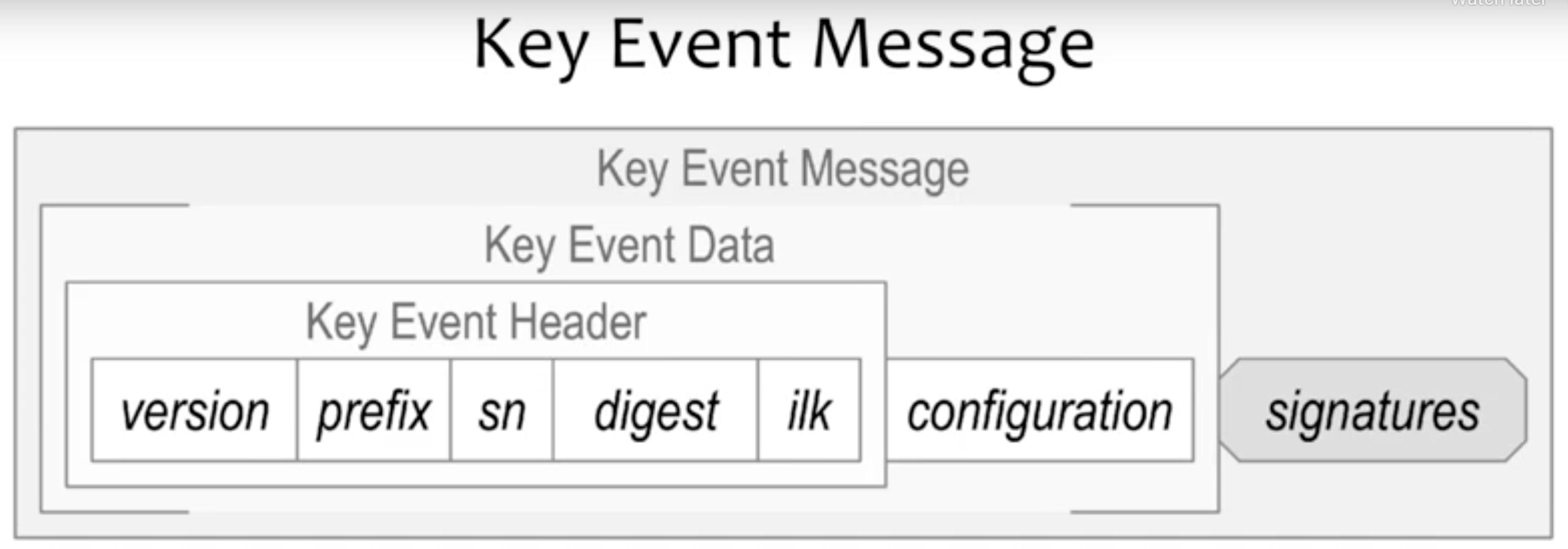
Key Event Log
Hash-chained Key Events, these are blockchains in a narrow definition, but not in the sense of ordering (not ordered) or global consensus mechanisms (not needed).
(SamMSmith)
A KEL is KERI’s VDS: the proof of key state of its identifier.
Key Event Receipt Log
Signed Key Events, keeping track of establishment events. To begin with the inception event and any number of rotation events. We call that the establishment subsequence.
(@henkvancann)
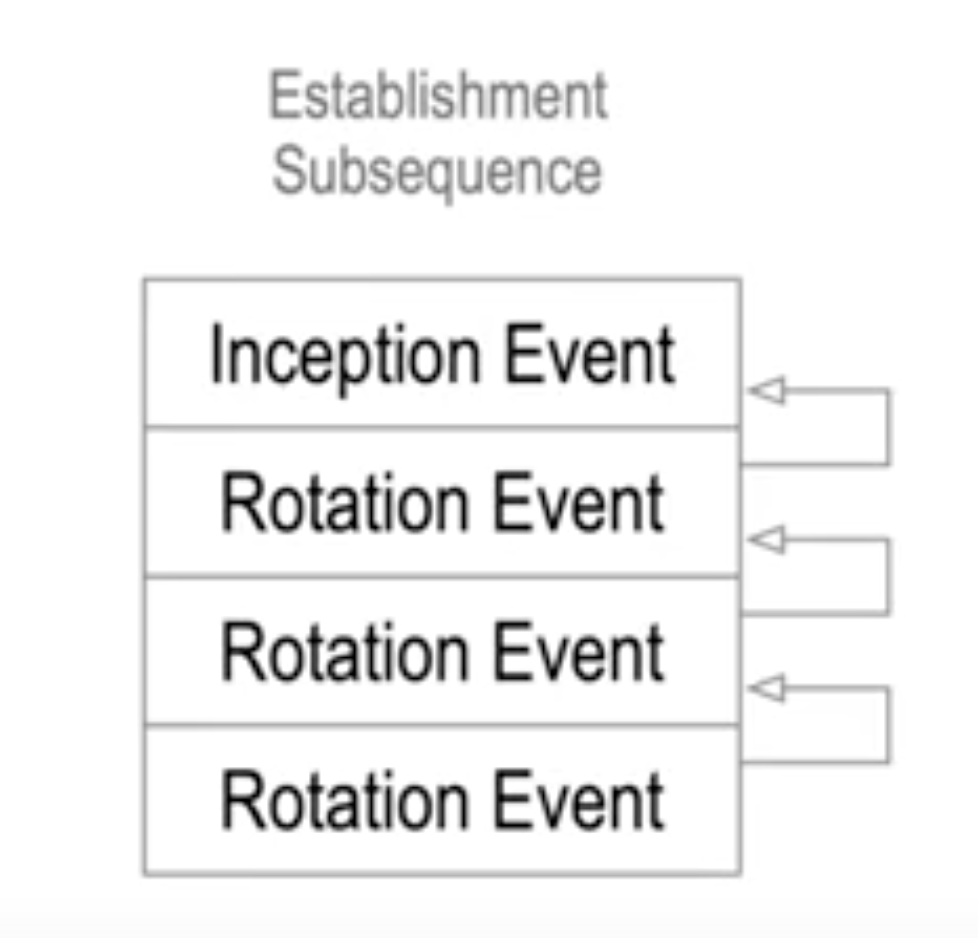
(SamMSmith)
Key Event State
Includes the mapping CNAME like, it also contain the witness data
The KES is never signed by the controller of the AID
{TBW}
KERI Implementation/Improvement Docs
Or KIDs. These docs are modular so teams of contributors can independently work and create PRs of individual KIDs; KIDs answer the question “how we do it”. We add commentary to the indivudual KIDs that elaborate on the why. It has been split from the how to not bother implementors with the why.
Level of Assurance
LOA; Identity and other trust decisions are often not binary. They are judgement calls. Any time that judgement is not a simple “Yes/No” answer, you have the option for levels of assurance. KERI has the same LOAs for entropy and trust in human behaviour preservering the security of keypairs and preservering their own privacy. It has high LOAs for the cryptographical bindings of controllers and identifiers. Also the validation of witnesses and watchtowers has high a LOA.
MultiCodec
Is a self-describing multiformat, it wraps other formats with a tiny bit of self-description. A multicodec identifier is both a varint and the code identifying data. See more at GitHub Multicodec Multicodec is an agreed-upon codec table. It is designed for use in binary representations, such as keys or identifiers (i.e CID). It is then used as a prefix to identify the data that follows.
Namespace
In an identity system, an identifier can be generalized to a namespace to provide a systematic way of organizing identifiers for related resources and their attributes. A namespace is a grouping of symbols or identifiers for a set of related objects. A namespace employs some scheme for assigning identifiers to the elements of the namespace. A simple name-spacing scheme uses a prefix or prefixes in a hierarchical fashion to compose identifiers. The following is an example of a namespace scheme for addresses within the USA that uses a hierarchy of prefixes:
state.county.city.zip.street.number.
An example element in this namespace may be identified with the following:
utah.wasatch.heber.84032.main.150S.
See also AN.
Non-Establishment Event
To be able to do something with the identifier, it anchors data to the key event sequence. So you can do things like issue or revoke a verifiable credential or engage in a transaction in which you give a commitment of some form to some other entity and you can anchor that commitment to the KER log and make it verifiable that way.
Non-transferable identifier
And identifier of which you can’t rotate its controlling private key. When the private key for a non-transferable identifier become exposed to potential compromise then the identifier must be abandoned by the controller as it is no longer secure.
The main innovation of KERI is that it provides a universal decentralized mechanism that supports both non-transferable and more importantly transferable self-certifying identifiers.
Normative
In general, we call a theory “normative” if it, in some sense, tells you what you should do - what action you should take. If it includes a usable procedure for determining the optimal action in a given scenario. Souce.
Non-normative
A theory is called non-normative if it does not do that. In general, the purpose of non-normative theories is not to give answers, but rather to describe possibilities or predict what might happen as a result of certain actions. Souce.
Payload
The term ‘payload’ is used to distinguish between the ‘interesting’ information in a chunk of data or similar, and the overhead to support it. It is borrowed from transportation, where it refers to the part of the load that ‘pays’: for example, a tanker truck may carry 20 tons of oil, but the fully loaded vehicle weighs much more than that - there’s the vehicle itself, the driver, fuel, the tank, etc. It costs money to move all these, but the customer only cares about (and pays for) the oil, hence, ‘pay-load’. source.
Now payload in KERI. The payload of an item in an Event Log is one the following cryptographical building blocks in KERI:
- a content digest hash
- a root hash of a Merkletree
- a public key
Note that the KERI never puts raw data or privacy sensitive data in a
KELorKERL.
Prefix
A prefix that is composed of a basic Base-64 (URL safe) derivation code prepended to Base-64 encoding of a basic public digital signing key.
Including the derivation code in the prefix binds the derivation process along with the public key to the resultant identifier.
An example of the prefix with a one character derivation code and a 32 byte public key encoded into a 44 character Based-64 string follows:
BDKrJxkcR9m5u1xs33F5pxRJP6T7hJEbhpHrUtlDdhh0

Public Key Infrastructure
A public key infrastructure (PKI) is a set of roles, policies, hardware, software and procedures needed to create, manage, distribute, use, store and revoke digital certificates and manage public-key encryption.
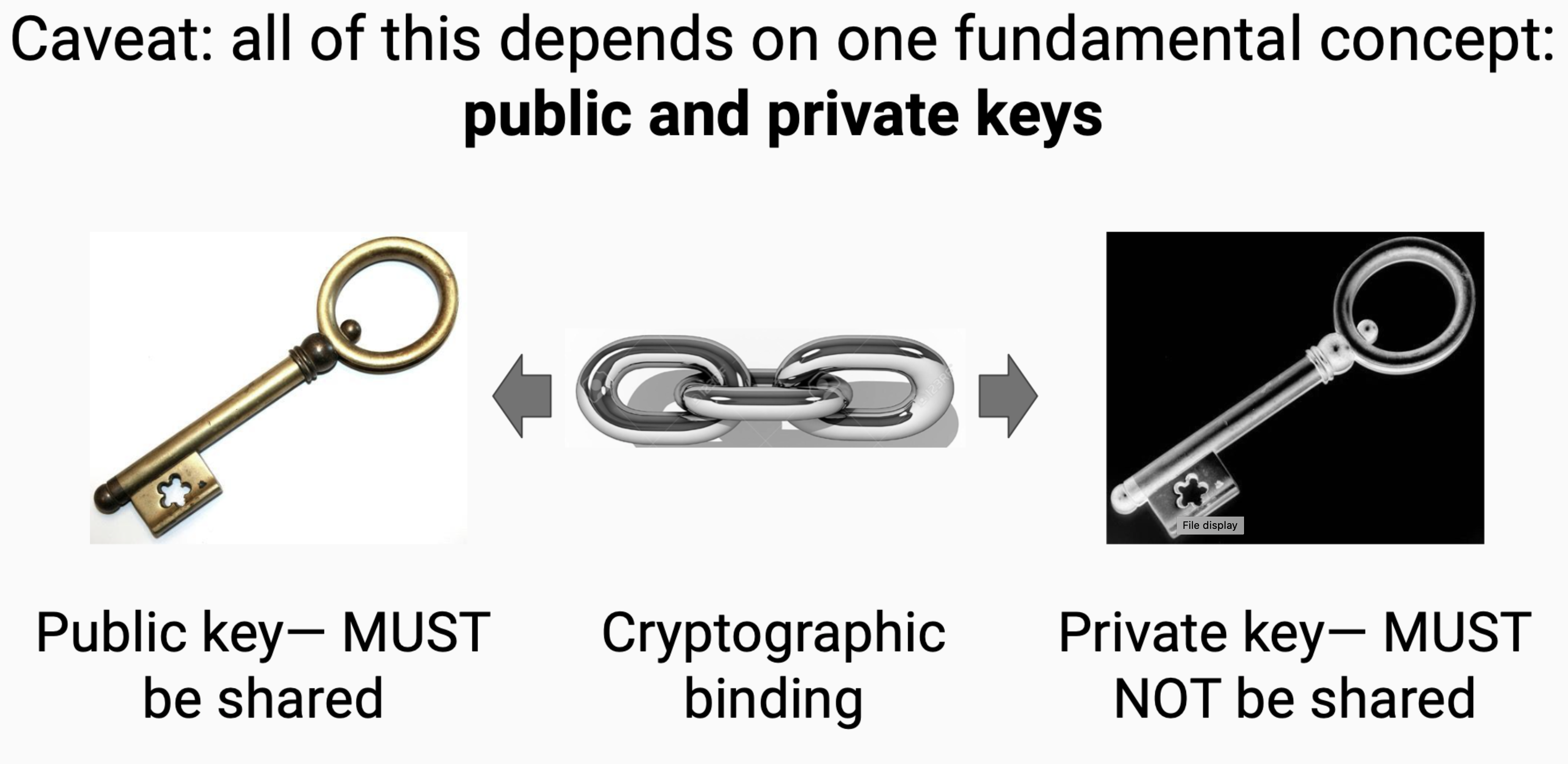 \
\
[Wikipedia].(https://en.wikipedia.org/wiki/Public_key_infrastructure)
Race condition
A race condition or race hazard is the condition of an electronics, software, or other system where the system’s substantive behavior is dependent on the sequence or timing of other uncontrollable events. It becomes a bug when one or more of the possible behaviors is undesirable. Source.
Root of trust
Replace human basis-of-trust with cryptographic root-of-trust. With verifiable digital signatures from asymmetric key cryptography we may not trust in “what” was said, but we may trust in “who” said it.
The root-of-trust is consistent attribution via verifiable integral non-repudiable statements.
A root of trust is a foundational component or process in the identity system that is relied on by other components of the system and whose failure would compromise the integrity of the bindings. A root of trust might be primary or secondary depending on whether or not it is replaceable. Primary roots of trust are irreplaceable. Together, the roots of trust form the trust basis for the system.
Rotation Event
A type of Establishment event that allows to change to authoritative public key. So we start with a root-of-trust in public private key pair that get down to the identifier, and then we can rotate authoritatively to other keypairs given signed rotation messages. The infrastructure that we need, keeps track of these rotations, or Key Event Receipt Infrastructure.
(SamMSmith)
Seal
A seal is a cryptographic anchor that provides evidence of authenticity; we have:
- Digist Seal (a digest of external data)
- Root Seal (the hash tree root of external data)
- Event Seal (includes the identifier prefix, sequence number, and digest of an event in a key event log)
- Event location Seal (includes the prefix, sequence number, ilk and prior digest from an event)
Seals deliver authenticity proofs in KERI.
Secret
Information controlled by an identity. MAY be used to derive _key_s.
Self Addressing Identifier
SAI, This is a self certfifying identifier (SCI) that has been attached to a certain context or infrastructure at the time of its inception. The inception configuration together with public key and it’s derivation, forms a digest (hash) plus it’s own derivation code that constitutes the Prefix of a self-addressing ID.
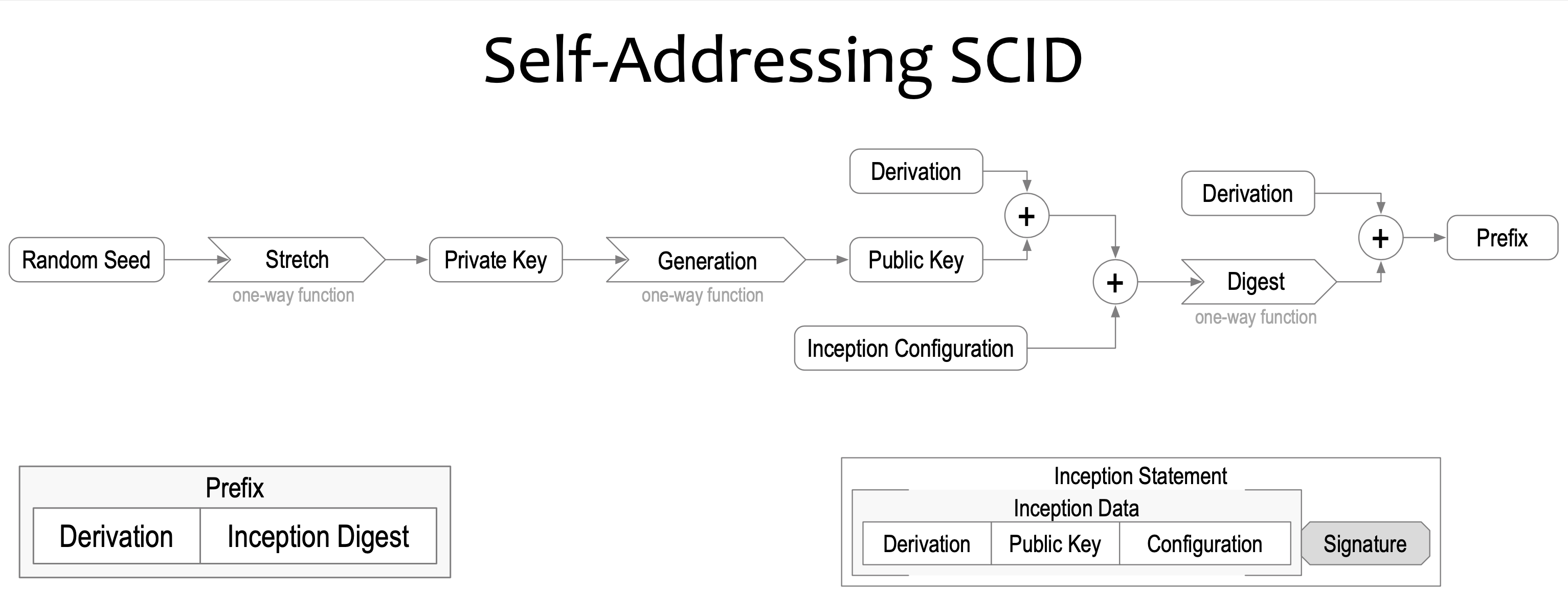
The binding in a Self-Addressing Identifier between inception data and private key can be created by replacing the public key in the identifier prefix with a content digest (hash) of the inception statement (that includes the public key). So it’s a further step of commitment to identifier information and also another level of hiding information at face value by one-way encryption beyond the inception statement. However all the information is end-verifiable.
Self Certifying Identifier
In brief: A self-certifying identifier cryptographically binds an identifier to a key-pair.
It is an identifier that can be proven to be the one and only identifier tied to a public key using cryptography alone.
A controller issues an own Identifier by binding a generated public private keypair to an identifier. After this a controller is able to sign the identifier and create a certificate. Also called a cryptonym. The simplest form of a self-certifying identifier includes either the public key or a unique fingerprint of the public key as a prefix in the identifier.

The root-of-trust is fully cryptographic, there is no infrastructure associated with it. If we start there we can build a secure system on top of that. It means SCI gives us strong bindings between the keypair, the controller and the identifier. And so it fixes the main weakness of any administratively issued identifier asserting the binding between the keypair and the identifier and between the controller and the identifier, replacing them with all cryptographically strong bindings.

Source is #SSI book.
Self Sovereign Identity
It is information given out by a party involved. It is empowering the individual to help governments doing their job. With SSI a criminal can’t cheat without being caught. SSI reduces the state’s expense per individual. SSI makes tough investigation easier and false judgements rarer. The mechanism verifies automaticly and handles broken cases gracefully.
SSI is a new model for Internet-scale digital identity based on an emerging set of protocols, cutting edge cryptography and open standards. Technological and social movements have come together that make SSI possible. (Source).
Decentralisation of the root-of-trust and verifiable credentials come into play and delivers “user-centric identity”: more control and self-determination of individuals, individuals machines and combinations of these, that identify as one.
(@henkvancann)
Spanning layer
An all encompassing layer horizontal layer in a software architecture. Each trust layer only spans platform specific applications. It bifurcates the internet trust map. There is no spanning trust layer.
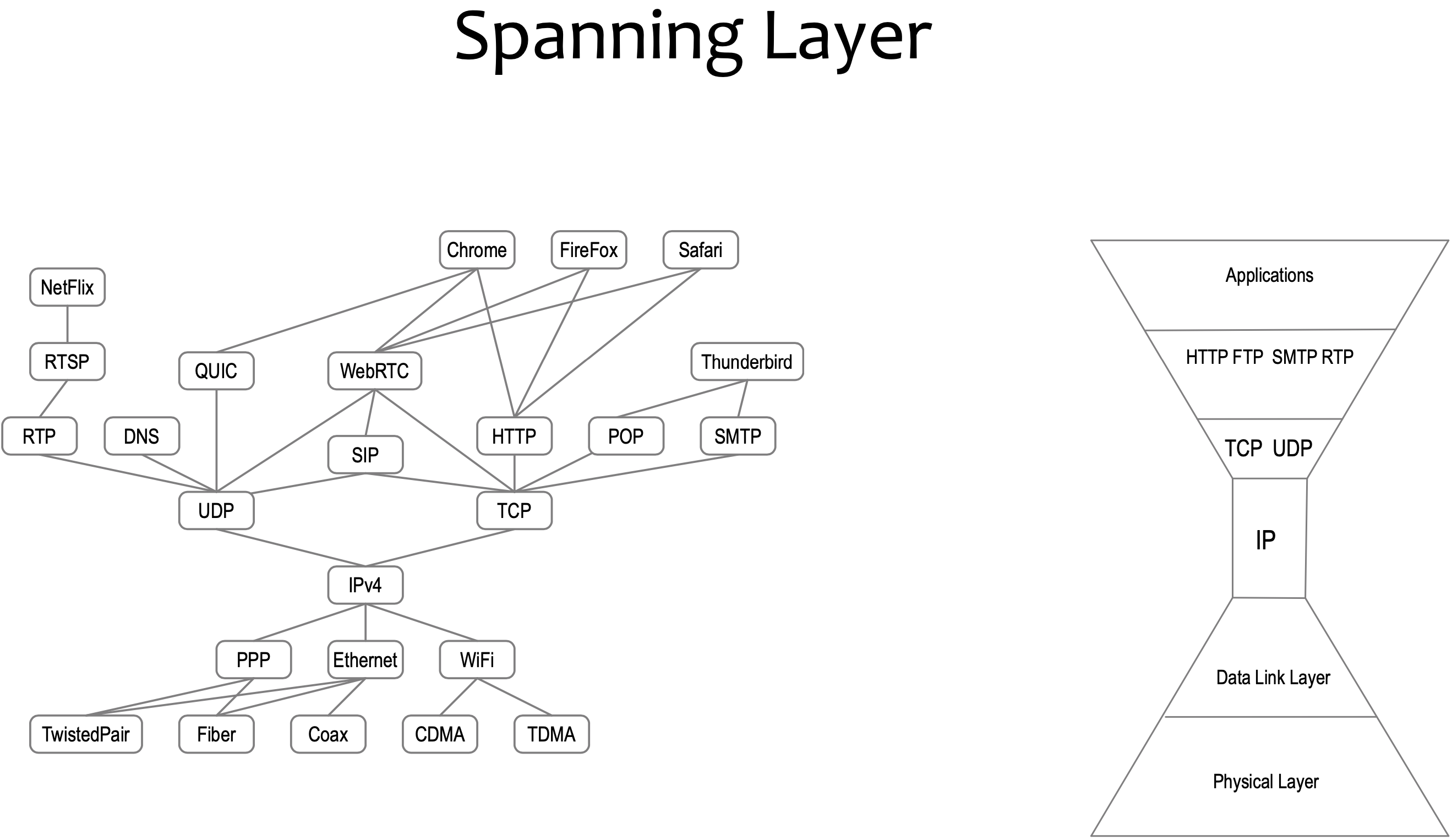
Subject
A digital subject: A person or thing represented or existing in the digital realm which is being described or dealt with. (Source).
Transaction Event Log
Also TEL: An externally anchored transactions via cryptographic commitments in a KEL.
The set of transactions that determine registry state form a log called a Transaction Event Log (TEL). The TEL provides a cryptographic proof of registry state by reference to the corresponding controlling KEL.
Any validator may therefore cryptographically verify the authoritative state of the registry.

Transfer
The process of changing the controller of cryptocurrency, identity or verifiable credential. MAY require the use of a key.
Transferable identifier
And identifier of which you can rotate its controlling private key. When the private key for a transferable identifier become exposed to potential compromise then control over the identifier may be transferred to a new key-pair to maintain security.
The main innovation of KERI is that it provides a universal decentralized mechanism that supports both non-transferable and more importantly transferable self-certifying identifiers.
Trust-over-IP
It’s a term related to the effort of a foundation. The Trust over IP Foundation is an independent project hosted at Linux Foundation to enable the trustworthy exchange and verification of data between any two parties on the Internet. More.

Validator
a validator is anybody that wants to estblish control-authority over an identifier, created by the controller of the identifier. Validators verify the log, they apply duplicity detection or they leverage somebody else’s duplicity detection or apply any other logic so they can say “Yes these are events I can trust”.
During validation of virtual credentials for example, a verifier checks to see if a verifiable credential (VC) has been signed by the controller of this VC using the applicable verification method.
Verifiable Credential
Verifiable Credentials standardize formal conversation. VCs structure discussion between two [or more] parties, it’s private and the proofs that an indvidual has got from an authority can’t be denied. Every statement can be checked, and no statement can be either deleted or changed.
VC; A data model for conveying claims made by an issuer about a subject. See vc-data-model for more.
Credentials are a part of our daily lives; driver’s licenses are used to assert that we are capable of operating a motor vehicle, university degrees can be used to assert our level of education, and government-issued passports enable us to travel between countries. This specification provides a mechanism to express these sorts of credentials on the Web in a way that is cryptographically secure, privacy respecting, and machine-verifiable. Know more
Verifiable Data Structure
Provides proof of key state for its identifier. In KERI it is the Key Event Log (KEL). Key management is embedded in KELs, including recovery from key compromise.
W3C DID
The W3C consortium Decentralized ID standardization. More.
WebAssembly
WASM, or just WA) is an open standard that defines a portable binary-code format for executable programs, and a corresponding textual assembly language, as well as interfaces for facilitating interactions between such programs and their host environment.
The main goal of WebAssembly is to enable high-performance applications on web pages, but the format is designed to be executed and integrated in other environments as well, including standalone ones. More info.
(Digital Identity) Wallet
In our context it is software and sometimes hardware that serves as a key store and functionality. Keys can be private keys and public keys, hashes and pointers. Functionality can be signing, invoices (receive), send, virtual credentials, delegation, etc. This is the agency part of a wallet.
More about digital ID Wallets
More about cryto Wallets.